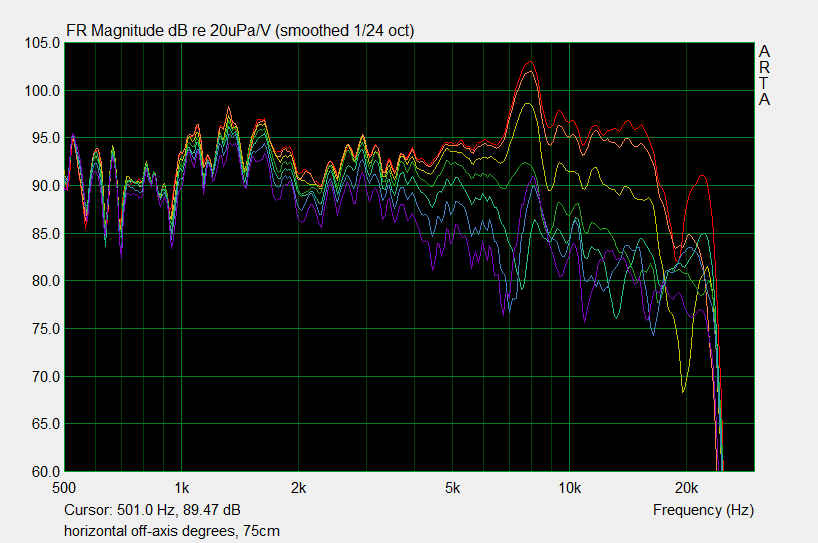IMO, this driver works a lot better in a horn than as a direct radiator. The image is FR plots of:
Top - in a short conical horn, with roundover to a flat baffle (no driver chamber / open backed).
The horn on-axis plot is the one with the big dip at 6.5kHz, peak at 7.5kHz. These anomalies only occur right on axis.*
Bottom - on an open baffle.
The OB on-axis plot is the one with the big peak. This peak stays strong 10 and 20 degrees off axis, but is gone by 30 degrees.
My graphs are on-axis & ~30 off axis, recorded ground plane (specifically: on carpet in a moderately big room) at 1m, smoothed to 24 thingamies per octave.
I note that my OB plot is similar to that shown in this other thread (my mic distance is greater, so probably more realistic for overall balance, but contains more room effects):
http://www.diyaudio.com/forums/multi-way/248666-fostex-ff105wk-experiments.html
...so it appears that:
a) I'm not making any huge mistakes with the measuring.
b) Whether in OB or a normal (small) box, the low end falls off sharply at 150Hz.
As a direct radiator, the driver needs LF boost: +5dB <1000Hz
...after the boost is applied, the best eq is to listen to the driver about 30-40 degrees off-axis. Once these conditions are met, you'd have a driver that covers 150Hz-8kHz.
As a horn driver, it needs LF cut: -5dB <2kHz.
...then listen anywhere off axis, you'd have a driver that covers 300Hz-15kHz, and is 10dB more efficient in the bottom (more demanding) part of its range.
*I've tested a bunch of DIY horns with a few 4" drivers. A couple of the round (axi symmetric) horns had this flaw of being worst when exactly on axis. Some drivers showed this more than others (still not sure why), and the Fostex does relatively well in this respect. The P-Audio 4" driver that I wanted to use performs better than the Fostex as a direct radiator, and is good in some horns, but did poorly in the conical horn.
The best on-axis response was from a much bigger horn, with a nearly square throat.
Top - in a short conical horn, with roundover to a flat baffle (no driver chamber / open backed).
The horn on-axis plot is the one with the big dip at 6.5kHz, peak at 7.5kHz. These anomalies only occur right on axis.*
Bottom - on an open baffle.
The OB on-axis plot is the one with the big peak. This peak stays strong 10 and 20 degrees off axis, but is gone by 30 degrees.
My graphs are on-axis & ~30 off axis, recorded ground plane (specifically: on carpet in a moderately big room) at 1m, smoothed to 24 thingamies per octave.
I note that my OB plot is similar to that shown in this other thread (my mic distance is greater, so probably more realistic for overall balance, but contains more room effects):
http://www.diyaudio.com/forums/multi-way/248666-fostex-ff105wk-experiments.html
...so it appears that:
a) I'm not making any huge mistakes with the measuring.
b) Whether in OB or a normal (small) box, the low end falls off sharply at 150Hz.
As a direct radiator, the driver needs LF boost: +5dB <1000Hz
...after the boost is applied, the best eq is to listen to the driver about 30-40 degrees off-axis. Once these conditions are met, you'd have a driver that covers 150Hz-8kHz.
As a horn driver, it needs LF cut: -5dB <2kHz.
...then listen anywhere off axis, you'd have a driver that covers 300Hz-15kHz, and is 10dB more efficient in the bottom (more demanding) part of its range.
*I've tested a bunch of DIY horns with a few 4" drivers. A couple of the round (axi symmetric) horns had this flaw of being worst when exactly on axis. Some drivers showed this more than others (still not sure why), and the Fostex does relatively well in this respect. The P-Audio 4" driver that I wanted to use performs better than the Fostex as a direct radiator, and is good in some horns, but did poorly in the conical horn.
The best on-axis response was from a much bigger horn, with a nearly square throat.
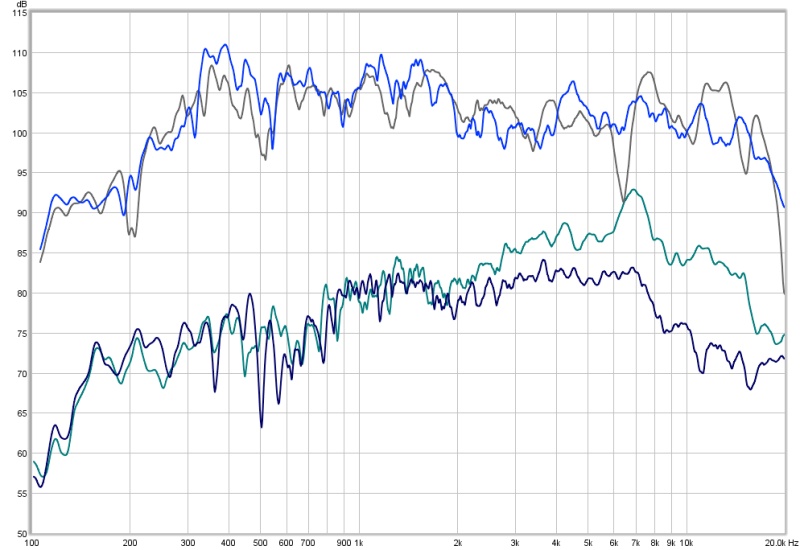
Nice result, I assume that the top two curves are the horn, and it seems to take care of the annoying 7.5kHz peak.
Glad you can show it works well full range out to 15kHz. A lot of people have told me full range horns will have a falloff cliff at about 4khz, and that doesn't appear to be the case here. I had similar experience with both TC9FD and 3FE22 having a nice response out to 18kHz.
Can you give more details on horn dims?
A photo would be great.
Last edited:
Yes, xrk971: those top 2 curves are the horn. Here is a photo of my test rig. I'm working (slowly) on the 'final' version: horn and two 30cm woofers in one box (picture of that also attached).
I just took some more measurements of the test horn.
Attached: ground plane, 50cm, with some pillows etc. placed to reduce reflections. It is thus a lazy man's anaechoic plot, and gives a much cleaner graph, but has killed off the treble. Maybe it is anomalies related to mic positioning and so on that has given rise to claims of "falloff cliff at about 4khz" ...perhaps, for horns, an in-room measurement gives a messier plot but a better indication of bandwidth.
Purple / top: the same OB plot as before (1m on axis measurement), as a baseline / reference.
Red & blue / bottom: on axis and about 20 degrees off axis. No smoothing at all - amazing how tidy a plot gets when you take the room out 🙂
Black / centre: the 20 degree graph, snapped in half with -5dB adjustment on the <2kHz section. This is all the eq I have been using; the remaining anomalies seem smaller than the effect of room reflections, or changes in mic / listening position.
I just took some more measurements of the test horn.
Attached: ground plane, 50cm, with some pillows etc. placed to reduce reflections. It is thus a lazy man's anaechoic plot, and gives a much cleaner graph, but has killed off the treble. Maybe it is anomalies related to mic positioning and so on that has given rise to claims of "falloff cliff at about 4khz" ...perhaps, for horns, an in-room measurement gives a messier plot but a better indication of bandwidth.
Purple / top: the same OB plot as before (1m on axis measurement), as a baseline / reference.
Red & blue / bottom: on axis and about 20 degrees off axis. No smoothing at all - amazing how tidy a plot gets when you take the room out 🙂
Black / centre: the 20 degree graph, snapped in half with -5dB adjustment on the <2kHz section. This is all the eq I have been using; the remaining anomalies seem smaller than the effect of room reflections, or changes in mic / listening position.
Attachments
Nice all wood carved horn. What is the profile and dimensions? Did you calculate it or is it a simple cone with round-overs?
Horn = 20cm deep and about 30cm wide, depending on how much of the roundover you include.
Some of my horn trials are based off 'name' contours (Le Cleach etc), but I also collect found objects like vases to cast horns from. I don't think exact profiles matter that much; since the experts often can't agree, or quibble over what separates them, I decided that the differences can't be that blatant, as long as there is nothing grossly wrong.
The centre of this horn is a found object: an Ikea fruit bowl. The roundover to the baffle was done with a router --> file --> sandpaper. I recently got a drill press, partly to make it easier to produce and test variant throats.
Godzilla: the OB I did the direct radiator testing on was just over 60*60cm, with the driver positioned a little off centre, about 20cm from the floor.
Some of my horn trials are based off 'name' contours (Le Cleach etc), but I also collect found objects like vases to cast horns from. I don't think exact profiles matter that much; since the experts often can't agree, or quibble over what separates them, I decided that the differences can't be that blatant, as long as there is nothing grossly wrong.
The centre of this horn is a found object: an Ikea fruit bowl. The roundover to the baffle was done with a router --> file --> sandpaper. I recently got a drill press, partly to make it easier to produce and test variant throats.
Godzilla: the OB I did the direct radiator testing on was just over 60*60cm, with the driver positioned a little off centre, about 20cm from the floor.
IMO, this driver works a lot better in a horn than as a direct radiator.
So I guess this is a bit like a mini VOTT. Nice experiment. I wish more people would try Fostex FR in front horns. They really can be amazing. The old FF125K was outstanding, and the FE108EZ likes front horns too. A long time ago I ran a mono system using an FE164 over an Altex 414 with an RS pod (oem FT17) supertweeter that sounded almost too good to be true.
I suggest you try it as a quasi FAST with a good big woofer (series crossover ~300hz) and a horn supertweeter with a 1uF high pass cap. I think you will dig it.
I think I would dig that too Greg B.
60x60cm - thanks for your measurements, this is about the size baffle I use.
60x60cm - thanks for your measurements, this is about the size baffle I use.
I have a 175Hz tractrix horn (from Volvotreter's spreadshest) designed for a 5in driver (PRV 5MR450NDY) that I can probably stick the FF105WK in and see what happens.
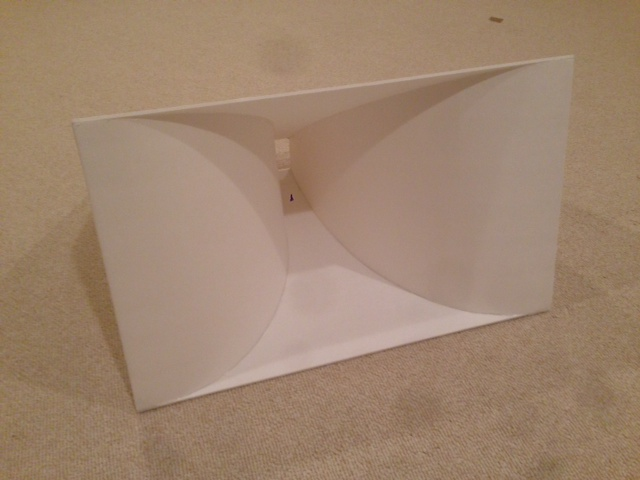
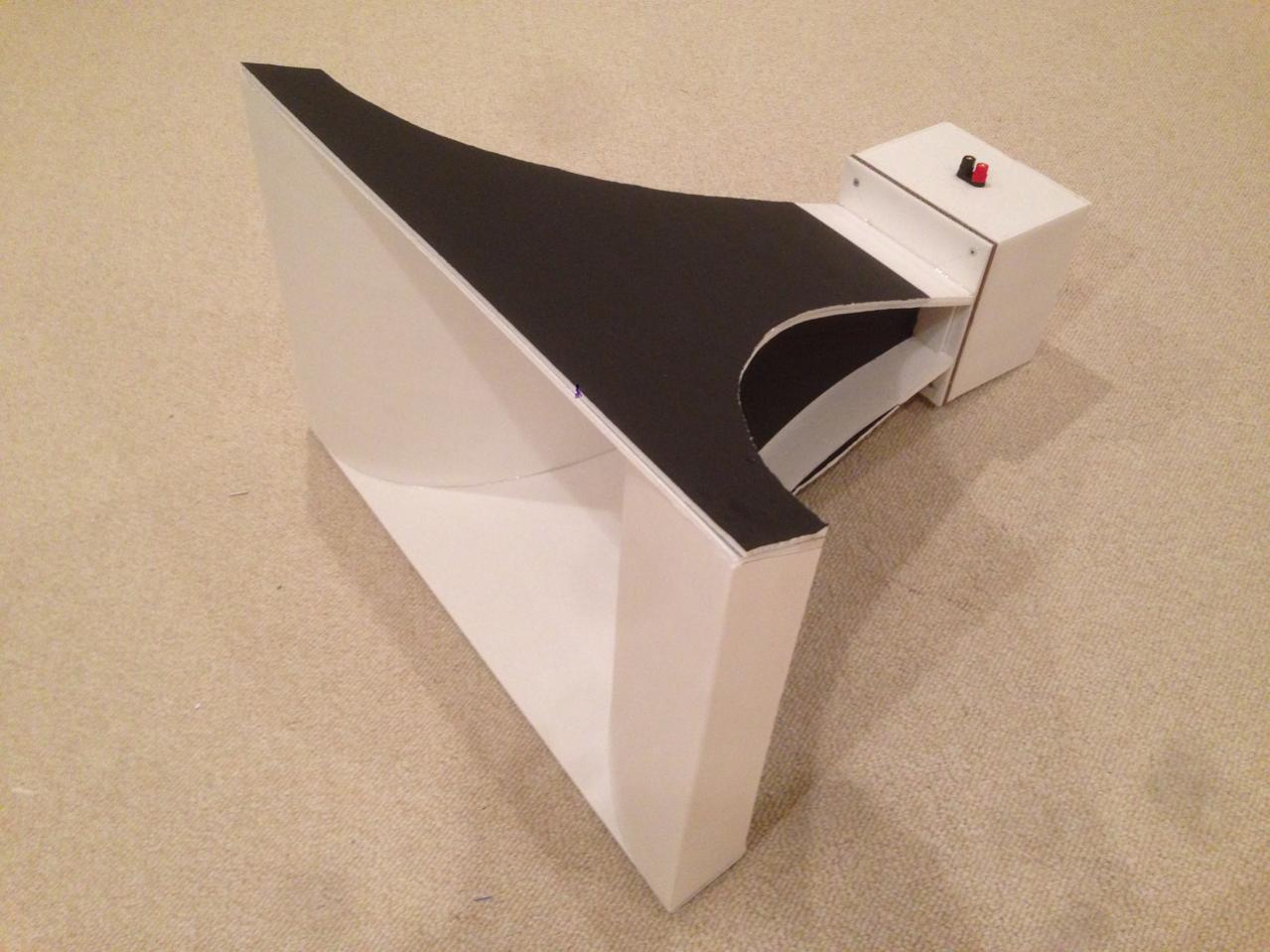
Here is the what I got with the 5MR450NDY (raw is black, EQ'd is red):
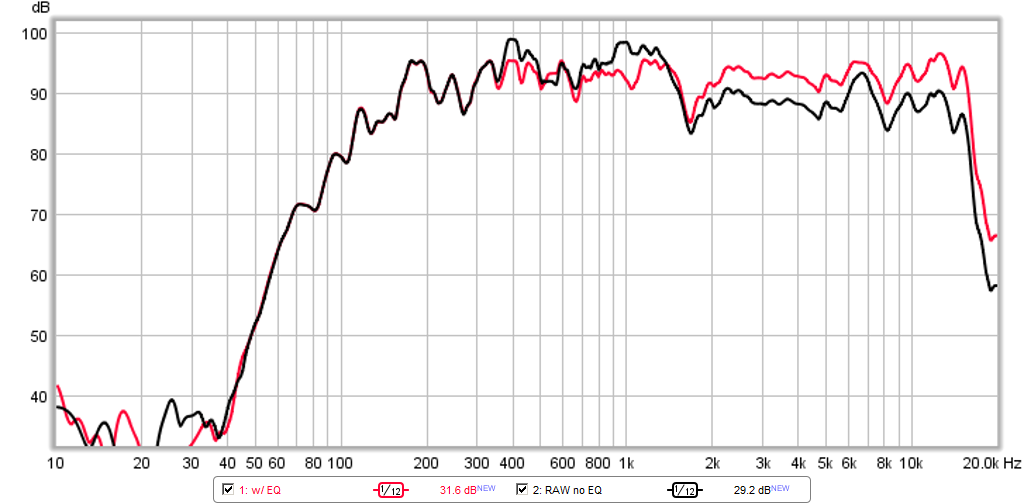
Polar response:
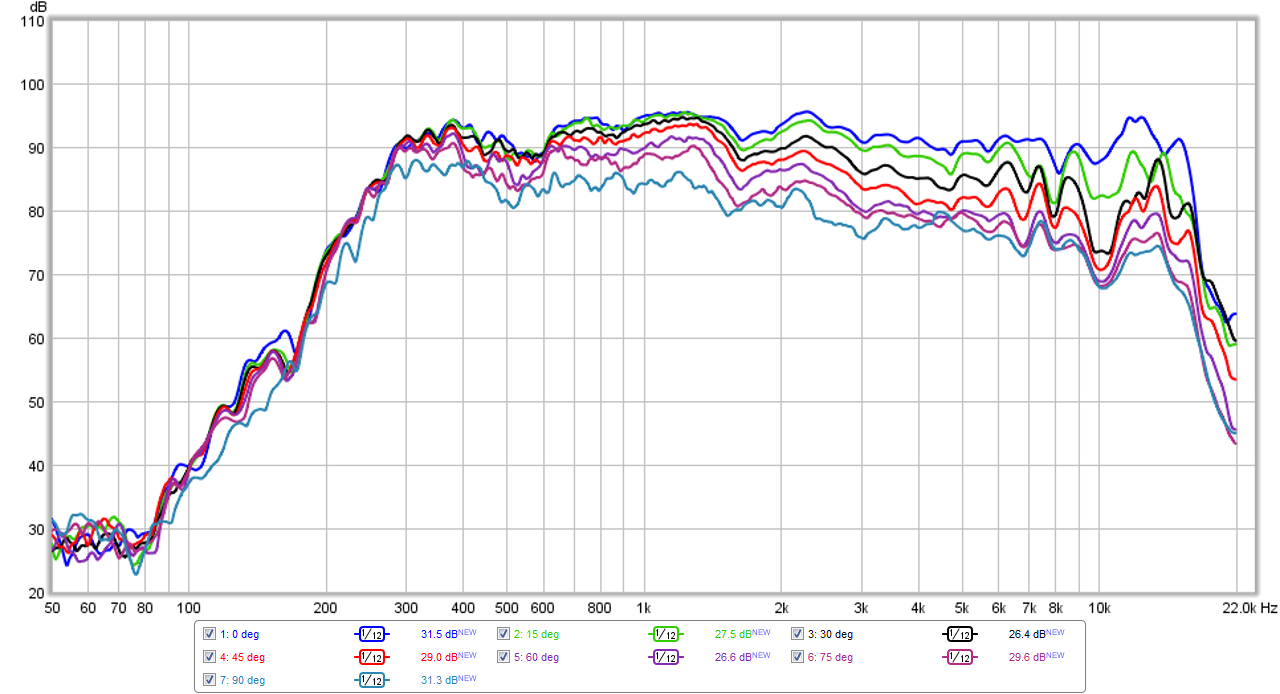
It had very low distortion and played very loud but was so clean, you can't tell how loud until ears start ringing - this is 98dB at 2m with only 1.6v applied, look at THD value of 0.1% before noise:
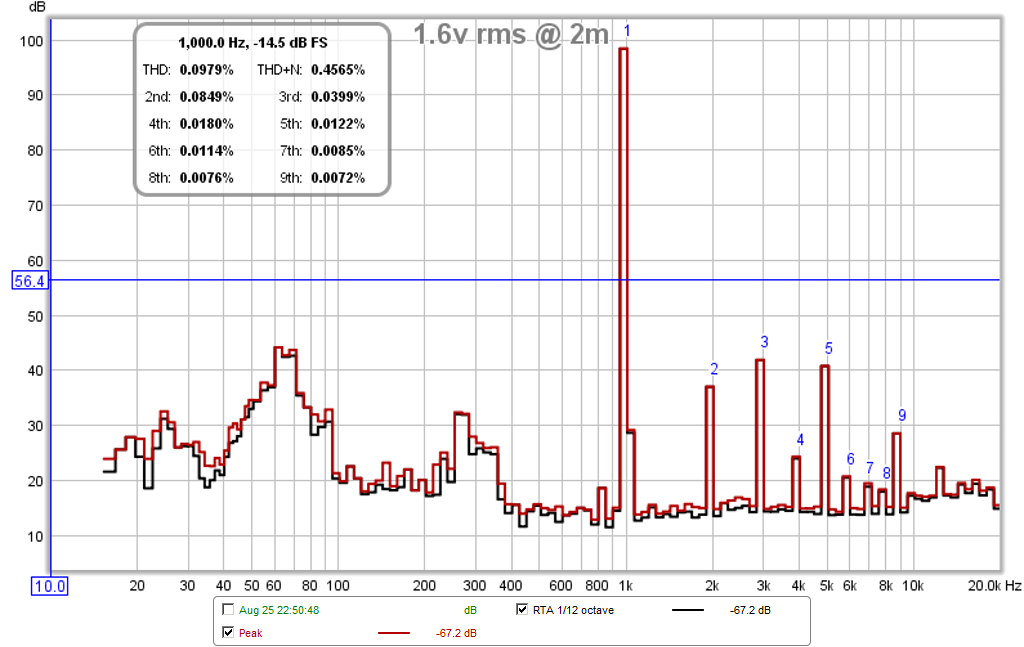


Here is the what I got with the 5MR450NDY (raw is black, EQ'd is red):

Polar response:

It had very low distortion and played very loud but was so clean, you can't tell how loud until ears start ringing - this is 98dB at 2m with only 1.6v applied, look at THD value of 0.1% before noise:

Last edited:
X: they look like different flavours of the same thing - both horn / driver combos seem to have similar bandwidth are to be reasonably flat once the <2kHz range is cut by about 5dB.
The PRV driver must be a bit more robust / capable of higher SPL.
Another driver that looks good for such horns is the TB W5-2143. Specs similar to the Fostex, optimistic manufacturer's FR plot like the Fostex, but more X-max and a handful of design differences that might add up to something good.
Greg: FAST is totally the plan, but using mini DSP. I'm still on the fence about the tweeter, and a few other choices. I tried some cheap dome tweeters, and even crossed super high, they are surprisingly awful. An old Foster bullet horn seemed to go much better.
The PRV driver must be a bit more robust / capable of higher SPL.
Another driver that looks good for such horns is the TB W5-2143. Specs similar to the Fostex, optimistic manufacturer's FR plot like the Fostex, but more X-max and a handful of design differences that might add up to something good.
Greg: FAST is totally the plan, but using mini DSP. I'm still on the fence about the tweeter, and a few other choices. I tried some cheap dome tweeters, and even crossed super high, they are surprisingly awful. An old Foster bullet horn seemed to go much better.
The PRV is a pro audio driver designed to take a beating. It has 225w rms Max thermal load and 450 w program rating. I can't imagine how loud that would be in a horn. I can barely handles giving it 8 watts without hurting my ears.
If you have miniDSP you can cross to a tweeter easily - just get one that is smooth 2 octaves below XO point if you want to use first order. So a dome would be XO at 5k or so and should be good.
If you have miniDSP you can cross to a tweeter easily - just get one that is smooth 2 octaves below XO point if you want to use first order. So a dome would be XO at 5k or so and should be good.
X: Yea, I followed your PRV thread with interest. With tweeters, I seem to be hard to please. With passives, and a high X-over, I found I had to go 3rd order before I was happy. Maybe I just need to try a better tweeter.
I just noticed the 3D printing thread. Page 2 appears to show (simulated) the same thing I showed / commented on here.
My graph is ragged with ~3dB artifacts from being a real in-room graph* rather than a sim, but it is interesting to see the large on-axis dip and following hump - big enough to show clearly through this artifact - look very much like Omni's simulation (again: on my graph, top is the horn, bottom is the OB, 0 and 30 degrees). I measured a similar trend with other axisymmetric horns.
Interesting for me is that a larger roundover reduced the severity of the dip in those sims. I imagine that some asymmetry would diminish it further. Despite them being so hot right now, I think round horns may not be the best option - that is, 80*100 degree coverage is probably a little better than 90*90.


* there's also a big, empty woofer cutout next to the horn mouth which probably does it no favours 🙂
I just noticed the 3D printing thread. Page 2 appears to show (simulated) the same thing I showed / commented on here.
My graph is ragged with ~3dB artifacts from being a real in-room graph* rather than a sim, but it is interesting to see the large on-axis dip and following hump - big enough to show clearly through this artifact - look very much like Omni's simulation (again: on my graph, top is the horn, bottom is the OB, 0 and 30 degrees). I measured a similar trend with other axisymmetric horns.
Interesting for me is that a larger roundover reduced the severity of the dip in those sims. I imagine that some asymmetry would diminish it further. Despite them being so hot right now, I think round horns may not be the best option - that is, 80*100 degree coverage is probably a little better than 90*90.


* there's also a big, empty woofer cutout next to the horn mouth which probably does it no favours 🙂
What's interesting to me is how different the chart is from 2000kHz down compared to the OB. I wonder if this is driver specific?
Interesting for me is that a larger roundover reduced the severity of the dip in those sims. I imagine that some asymmetry would diminish it further. Despite them being so hot right now, I think round horns may not be the best option
I've often had the same thought. There are however arguments to be made for round horns. If I ever have the means, I'd like to try LeCleac'h type horns sometime. The giant roundover incorporated into the expansion just seems like a good idea.
The best sounding conicals I've DIY'ed were much like the current JBL horns, IOW a sort of trapezoidal shape with the sides arched inward slightly.
Another type on my to do list would be a tractrix profile radial horn. In other words a true tractrix profile rotated about a 60 degree (or greater) arc.
I'm still not convinced of the Edgar type tractrix horn, wherein the CSA of the expansion is calculated to match a theoretical round horn. This method makes sense with expo horns, but clashes with the original justification for 'spherical' tractrix horns. Whether or not that matters, I don't know.
'If I ever have the means, I'd like to try LeCleac'h type horns sometime'
Sorry if I have missed something dumb - what prevents you from having the means?
You could build them in foamcore, as X did.
To get a little more fancy, the linked build is pretty impressive looking, but is basically an X build with more patience (and money) applied. Doesn't need that much space, or tools, and wouldn't be noisy - no power tools to disturb the neighbors.
doityourselfaudio: 140Hz Petal Horns
I've knocked together horns from a combo of ply and paper mache, as pictured*. The technique
-isn't rocket surgery
-the frame doesn't take too long
-is a slow but silent build after that (I love listening to music while making a speaker to listen to music...)
-is a good use of scraps / offcuts / salvage, so costs very little
Note: if you were more clever than I was, you'd cut a few holes into the large side panels right at the beginning, to make it easy to add resin / fibreglass / goo / whatever to the back of the horn curve.
All of the above can be adapted to pretty much any profile, and to non-round mouths.
'Another type on my to do list would be a tractrix profile radial horn. In other words a true tractrix profile rotated about a 60 degree (or greater) arc.'
Would you mind adding a link or picture? I'm not sure I know what you mean.
*this was another axisymmetric horn that has a choppy on-axis curve and OK off axis curves. I still have it ...I should try making another one, with an oval mouth, to see if that improves / removes the on-axis anomaly.
Sorry if I have missed something dumb - what prevents you from having the means?
You could build them in foamcore, as X did.
To get a little more fancy, the linked build is pretty impressive looking, but is basically an X build with more patience (and money) applied. Doesn't need that much space, or tools, and wouldn't be noisy - no power tools to disturb the neighbors.
doityourselfaudio: 140Hz Petal Horns
I've knocked together horns from a combo of ply and paper mache, as pictured*. The technique
-isn't rocket surgery
-the frame doesn't take too long
-is a slow but silent build after that (I love listening to music while making a speaker to listen to music...)
-is a good use of scraps / offcuts / salvage, so costs very little
Note: if you were more clever than I was, you'd cut a few holes into the large side panels right at the beginning, to make it easy to add resin / fibreglass / goo / whatever to the back of the horn curve.
All of the above can be adapted to pretty much any profile, and to non-round mouths.
'Another type on my to do list would be a tractrix profile radial horn. In other words a true tractrix profile rotated about a 60 degree (or greater) arc.'
Would you mind adding a link or picture? I'm not sure I know what you mean.
*this was another axisymmetric horn that has a choppy on-axis curve and OK off axis curves. I still have it ...I should try making another one, with an oval mouth, to see if that improves / removes the on-axis anomaly.
Attachments
"What's interesting to me is how different the chart is from 2000kHz down compared to the OB. I wonder if this is driver specific?"
That difference is a large part of why I'm making horns 🙂
No horn: 5dB boost required below 800Hz.
In horn: 5dB cut required below 2kHz.
Having a full range driver produce 10dB more output from the same power / excursion is a big deal.
The difference is not driver specific; I get (broadly) the same results from different drivers. I'm about to post some more graphs, which should be illustrative. The horn doesn't change the driver's basic character either - for example, the Fostex has a mild 2kHz dip open baffle, which can still be seen in the response when horn loaded.
That difference is a large part of why I'm making horns 🙂
No horn: 5dB boost required below 800Hz.
In horn: 5dB cut required below 2kHz.
Having a full range driver produce 10dB more output from the same power / excursion is a big deal.
The difference is not driver specific; I get (broadly) the same results from different drivers. I'm about to post some more graphs, which should be illustrative. The horn doesn't change the driver's basic character either - for example, the Fostex has a mild 2kHz dip open baffle, which can still be seen in the response when horn loaded.
I put together an oval horn, mouth 280*340mm, and compared that to the round (280mm) horn - same distance, mic position (1m, horns and mic about 30cm from the floor).
I used two drivers, the Fostex from the title, and a similar P-Audio unit. The cone:throat is almost 1:1 (no compression).
Caveats:
-the oval horn is obviously slightly larger, meaning a little more depth to get to the same throat size. The round horn was smaller, but on a baffle. I don't think the <500Hz part is comparable.
-the P-Audio driver is a few mm larger.
-I'm not as rigorous as some, so my "on axis" might be 1 degree off for graph A and 3 degrees off for graph B
-no gating, no special shenanigans, so this has room artifacts.
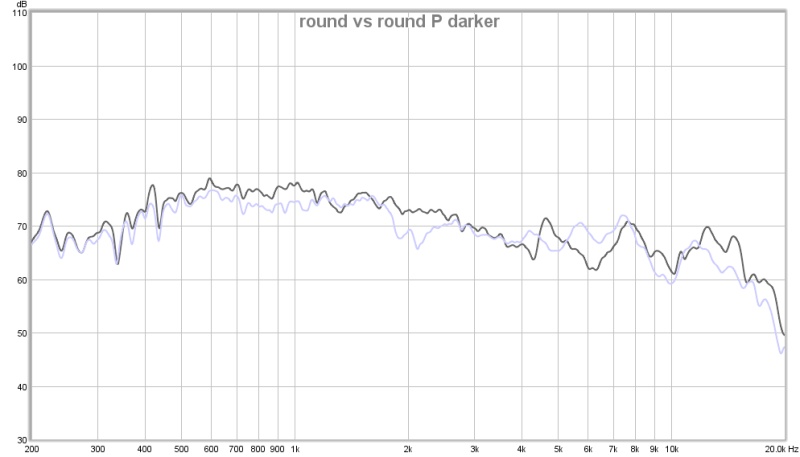

These graphs are from REW*, an average of four measurements: on-axis, 10, 20 30 degrees off axis. The Fostex is the paler trace in both, and has the 2kHz dip in both.
The Fostex prefers the round horn, and the P-Audio seems happy either way. Doesn't seem to have been worth the effort!
*REW averaging seems to weigh peaks heavily - that is, a peak that is only present on 1 graph shows much more clearly than a dip which is only present on 1 graph.
I used two drivers, the Fostex from the title, and a similar P-Audio unit. The cone:throat is almost 1:1 (no compression).
Caveats:
-the oval horn is obviously slightly larger, meaning a little more depth to get to the same throat size. The round horn was smaller, but on a baffle. I don't think the <500Hz part is comparable.
-the P-Audio driver is a few mm larger.
-I'm not as rigorous as some, so my "on axis" might be 1 degree off for graph A and 3 degrees off for graph B
-no gating, no special shenanigans, so this has room artifacts.
These graphs are from REW*, an average of four measurements: on-axis, 10, 20 30 degrees off axis. The Fostex is the paler trace in both, and has the 2kHz dip in both.
The Fostex prefers the round horn, and the P-Audio seems happy either way. Doesn't seem to have been worth the effort!
*REW averaging seems to weigh peaks heavily - that is, a peak that is only present on 1 graph shows much more clearly than a dip which is only present on 1 graph.
Attachments
This is a more detailed comparison of the drivers on the round horn. In each graph, the Fostex is the paler trace. The drivers are more alike than different.
The P-Audio is more ragged on axis (4-10kHz), but it flattens out more rapidly as the mic position moves off axis.
Either driver is best off axis, with simple shelving to reduce the output below ~2kHz.
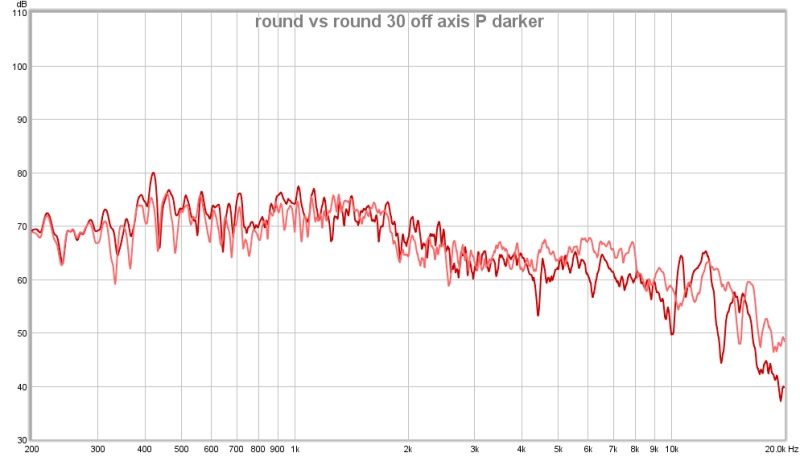
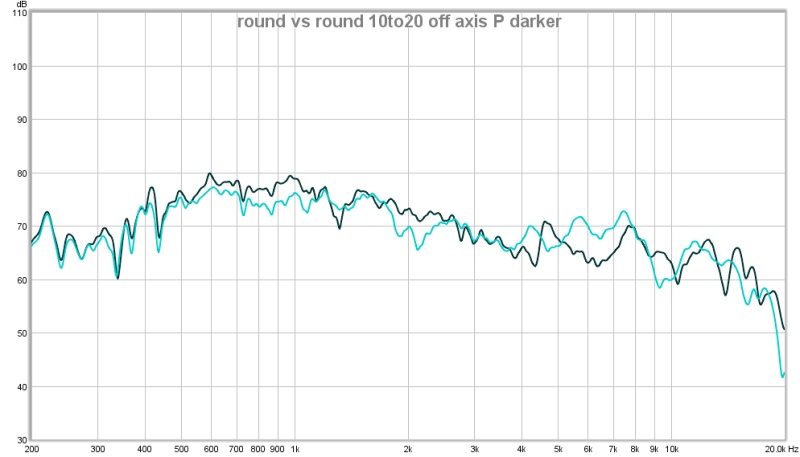
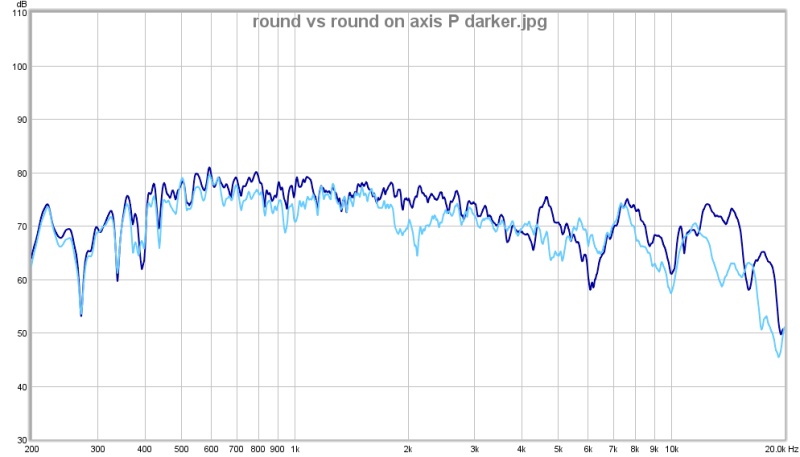
The P-Audio is more ragged on axis (4-10kHz), but it flattens out more rapidly as the mic position moves off axis.
Either driver is best off axis, with simple shelving to reduce the output below ~2kHz.
Attachments
- Status
- Not open for further replies.
- Home
- Loudspeakers
- Full Range
- Fostex FF105WK in conical horn
